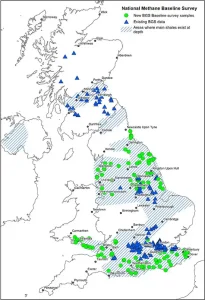Methane (CH4) occurs naturally in the atmosphere and is commonly found at trace levels as a dissolved component of groundwater. CH4 is also released by human activity and is an important greenhouse gas.
BGS surveyed the current distribution of CH4 concentrations in UK groundwaters, focusing on areas where aquifers are underlain by shale units that may be exploited for shale gas. The dataset is a reference point against which any future changes in groundwater CH4 concentrations can be measured and it is of particular interest to researchers and environmental regulators.
- Summary of the CH4 baseline results with links to the regional summaries

Collecting dissolved gases into an evacuated glass bulb for research into methane in UK groundwater. BGS © UKRI.
The need for UK CH4 baseline data
The need for a CH4 baseline in the UK was recognised in the 2012 report on shale gas extraction, published by the Royal Society and Royal Academy of Engineering (pdf).
Understanding the current distribution of CH4 in UK groundwaters provides a baseline against which any future changes can be measured. This has become particularly important with increasing interest in shale gas in the UK.
Evidence from the USA has shown very high CH4 concentrations in some aquifers in some of the areas where shale rocks are being commercially exploited for gas. However, there is considerable uncertainty and argument over the source(s) of the CH4 and how it has entered the aquifers. Crucially, there was no consistent baseline data on CH4 concentrations in groundwater in the USA collected before shale gas exploitation began, which makes it very difficult to assess and deal with the observed problems of CH4 in groundwater.

Map showing the distribution of CH4 baseline data for UK groundwaters. Summary results are available. BGS © UKRI.
BGS scientists built on our previous work and measured CH4 concentrations in groundwater in a range of aquifers before any shale gas development started. This provides a baseline against which any future environmental changes can be assessed and will enable informed management decisions to be taken. The CH4 baseline is defined for this project as the current background range of CH4 concentrations in UK groundwaters before any significant exploitation of unconventional hydrocarbons, such as shale gas, takes place.
The measured CH4 may not necessarily originate naturally from geological sources — in some cases, it may have been produced or released because of other human activities, such as coal mining or landfill operations.
Fieldwork and sampling
Collecting groundwater samples for CH4 analysis is straightforward, providing certain precautions are undertaken.
To get an accurate concentration measurement, groundwater has to be sampled before it comes into contact with air so that no gas can escape. This means collecting a sample directly from a pumped borehole, by attaching a hose with an airtight connection at the top of the borehole before the pumped water enters a storage tank or is treated in any way.

Sampling groundwater for CH4 in Lancashire. BGS © UKRI.
Special containers are used to preserve the sample until it reaches the laboratory. In addition to sampling for dissolved CH4, a number of chemical parameters are measured in the field (for example, groundwater temperature, dissolved oxygen content and redox potential) and samples are collected for laboratory analysis of a broader range of chemical parameters.
- Find out more information about the national baseline groundwater chemistry programme
Partners
BGS greatly appreciates the support provided by the Environment Agency, Natural Resources Wales, water utility companies and other private borehole owners such as farms and golf courses to find suitable boreholes,
Further reading
Bell, R A, Darling, W G, Ward, R S, Basava-Reddi, L, Halwa, L, Manamsa, K, and Ó Dochartaigh, B É. 2017. A baseline survey of dissolved methane in aquifers of Great Britain. Science of the Total Environment, Vol. 601–602, 1803–1813. DOI: https://doi.org/10.1016/j.scitotenv.2017.05.191
Bell, R A, Darling, W G, Manamsa, K, and Ó Dochartaigh, B É. 2016. The baseline concentrations of methane in Great British groundwater — the National Methane Baseline Survey. British Geological Survey Open Report OR/15/071. (Nottingham, UK: British Geological Survey.)
Methane data from previous BGS water quality surveys
Methane data from previous BGS water quality surveys has been published in papers and reports that are available from the NERC Open Research Archive (NORA). Please note that a small amount of data from these published sources has not been used in the statistical summaries for the regions presented in the accompanying web pages because they were considered unrepresentative of typical baseline conditions.
Gooddy, D, and Darling, W G. 2005. The potential for methane emissions from groundwaters of the UK. Science of the Total Environment, Vol. 339, 117–126. DOI: http://dx.doi.org/10.1016/j.scitotenv.2004.07.019
Darling, W G, and Gooddy, D C. 2006. The hydrogeochemistry of methane: evidence from English groundwaters. Chemical Geology, Vol. 229(4), 293–312. DOI: http://dx.doi.org/10.1016/j.chemgeo.2005.11.003
Ó Dochartaigh, B E, Smedley, P L, MacDonald, A M, Darling, W G, and Homoncik, S. 2011. Baseline Scotland: groundwater chemistry of the Carboniferous sedimentary aquifers of the Midland Valley. British Geological Survey Open Report OR/11/021. (Nottingham, UK: British Geological Survey.)

